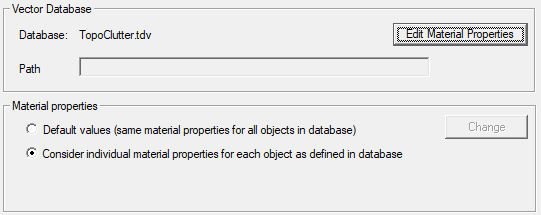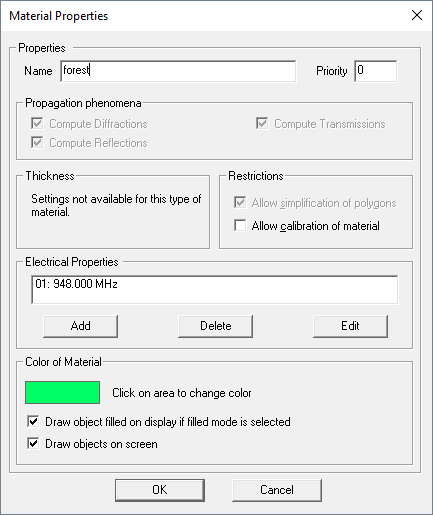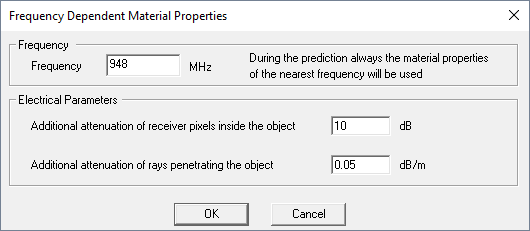Rural 3D Objects: Material Properties
Rural topography, clutter and building vector objects can be modeled using individual material properties for each 3D object.
View and Edit Material Properties
Rural topography, clutter and building vector objects can be modeled using individual material properties for each 3D object. The assigned material properties are stored in a material database, which is part of the rural vector database.
All defined settings for the individual materials can be edited in ProMan and WallMan.
To view the material table in ProMan, which lists all materials defined for a database, click or by clicking on the and click on the Database tab.

Figure 1. The Vector Database dialog.
To import materials in WallMan, click .

Figure 2. The Import material from catalogue dialog in WallMan.
- Show & modify
- Open the Material Properties dialog to view or edit the material parameters for the selected material.
- Save changes
- Save the material table to a material catalogue file (.mcb), which makes it possible to import all or only selected material definitions into other building databases.
After selecting a material from the material list by double clicking on a material, the Material Properties dialog opens, where the settings of the selected material can be changed.

Figure 3. The Material Properties dialog.
- Name
- Arbitrary name of the material.
- Propagation Phenomena
- The consideration of propagation phenomena (diffraction, reflection,
transmission) in ray-tracing simulations can be enabled or disabled for each
material individually. These settings are considered during pre-processing for the
ray-tracing propagation models and therefore cannot be changed in ProMan.Note: These settings can only be changed in WallMan.
- Thickness
- Thickness of the material. Only relevant for visualization and for computation with Fresnel coefficients.
- Restrictions
- Allow or prohibit simplification of polygonal objects with this
material.Note: This option can only be changed in WallMan.
- Electrical Properties
- Electrical properties of the material for different frequency bands.Note: The nearest defined frequency for a material is used during the prediction.
Frequency depending properties of a material can be edited with the following dialog:

Figure 4. The Frequency Depending Material Properties dialog.
- Frequency
- Frequency for the specified material properties.Note: The nearest defined frequency for a material is used during the prediction.
- Parameters for empirical transmission/reflection/diffraction model
- Attenuation values for the different propagation phenomena that are used for the empirical transmission / reflection / diffraction model during ray-tracing simulations.
- Parameters for Fresnel coefficients and GTD / UTD model
- Material parameters for calculating attenuation using Fresnel coefficients (transmission, reflection) and GTU / UTD (diffraction) during ray-tracing simulations.